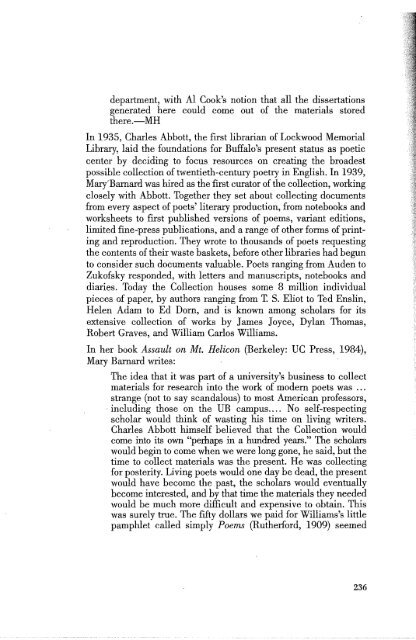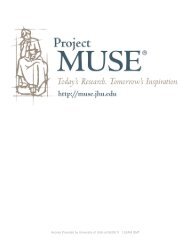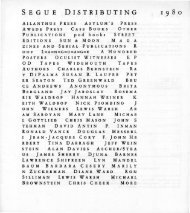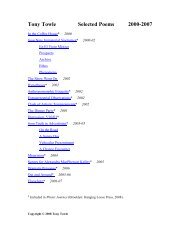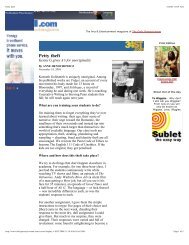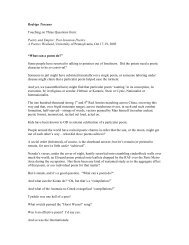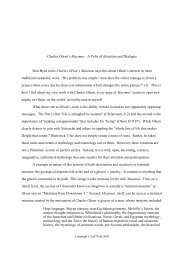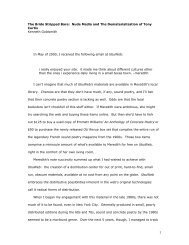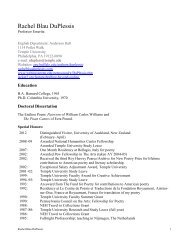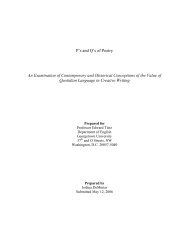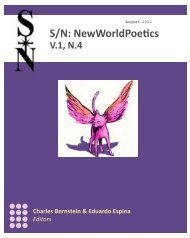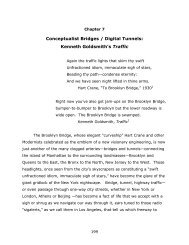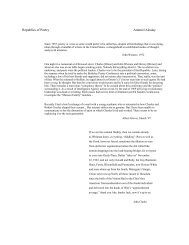Poetry & Poetics at Buffalo - Electronic Poetry Center - University at ...
Poetry & Poetics at Buffalo - Electronic Poetry Center - University at ...
Poetry & Poetics at Buffalo - Electronic Poetry Center - University at ...
Create successful ePaper yourself
Turn your PDF publications into a flip-book with our unique Google optimized e-Paper software.
department, with Al Cook's notion th<strong>at</strong> all the dissert<strong>at</strong>ions<br />
gener<strong>at</strong>ed here could come out of the m<strong>at</strong>erials stored<br />
there.-MH<br />
In 1935, Charles Abbott, the first librarian of Lockwood Memorial<br />
Library, laid the found<strong>at</strong>ions for <strong>Buffalo</strong>'s present st<strong>at</strong>us as poetic<br />
center by deciding to focus resources on cre<strong>at</strong>ing the broadest<br />
possible collection of twentieth-century poetry in English. In 1939,<br />
MarfBarnarrl was hired as the first cur<strong>at</strong>or ofthe collection, working<br />
closely with Abbott. Together they set about collecting documents<br />
from every aspect of poets' literary production, from notebooks and<br />
worksheets to first published versions of poems, variant editions,<br />
limited fine-press public<strong>at</strong>ions, and a range of other forms of printing<br />
and reproduction. They wrote to thousands of poets requesting<br />
the contents of their waste baskets, before other libraries had begun<br />
to consider such documents valuable. Poets ranging from Auden to<br />
Zukofsky responded, with letters and manuscripts, notebooks and<br />
diaries. Today the Collection houses some 8 million individual<br />
pieces of paper, by authors ranging from T. S. Eliot to Ted Enslin,<br />
Helen Adam to Ed Dorn, and is known among scholars for its<br />
extensive collection of works by James Joyce, Dylan Thomas,<br />
Robert Graves, and William Carlos Williams.<br />
In her book Assault on Mt. Helicon (Berkeley: DC Press, 1984),<br />
Mary Barnard writes:<br />
The idea th<strong>at</strong> it was part of a university's business to collect<br />
m<strong>at</strong>erials for research into the work of modern poets was ...<br />
strange (not to say scandalous) to most American professors,<br />
. including those on the DB campus.... No self-respecting<br />
scholar would think of wasting his time on living writers.<br />
Charles Abbott himself believed th<strong>at</strong> the Collection would<br />
come into its own "perhaps in a hundred years." The scholars<br />
would begin to come when we were long gone, he said, but the<br />
time to collect m<strong>at</strong>erials was the present. He was collecting<br />
for posterity. Living poets would one day be dead, the present<br />
would have become the past, the scholars would eventually<br />
become interested, and by th<strong>at</strong> time the m<strong>at</strong>erials they needed<br />
would be much more difficult and expensive to obtain. This<br />
was surely true. The fifty dollars we paid for Williams's little<br />
pamphlet called simply Poems (Rutherford, 1909) seemed<br />
236


